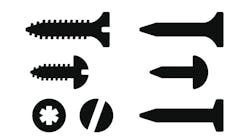Attaching metal pieces to one another with a screw is relatively straightforward. But using threaded fasteners on plastics, which are lightweight, low-density materials compared to metals, can be tricky. That’s because it is critical to select self-tapping screws that maximize stripping torque—that is, the torque at which the fastener’s threads begin to strip the plastic.
In general, tapping screws for plastics are inserted into pre-drilled or pre-formed holes and then manually or automatically driven. The flank area on such a screw should be as large as practical, similar to a sheet-metal screw. Thread spacing should be wide, usually twice that of a machine screw.
If the screw will be installed in a commercial-grade plastic, it usually has a blunt point. For harder plastics such as phenolics, the blunt point has a slotted shank that can provide additional cutting action. For the hardest plastics, the screw could need a slotted-shank screw with a conical point.
When screws are driven automatically into plastic at high rpm, it can generate enough frictional heat to damage or deform the plastic. To prevent this, reduce the drive’s rpms or use a twin-helix screw. A twin screw has two sets of thread, each running in a helix from tip to the head, much like the two stings of genes in a DNA molecule.
Some fasteners create high hoop or radial stresses in plastic, and these stresses can lead to immediate or eventual failure. To minimize hoop stresses, use tri-lobed screws with slender thread angles. These screws form deep internal threads in the plastic while generating less hoop stress.
If a situation arises and it is impractical to turn or drive a fastener without the plastic failing, a nail-type of fasten might be in order. These fasteners have barbs, rings, or some type of edged protrusion that bites into the plastic more cleanly than just threads.
